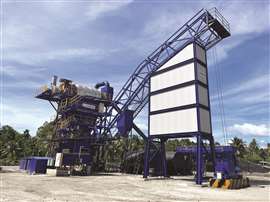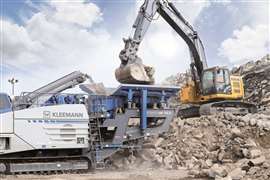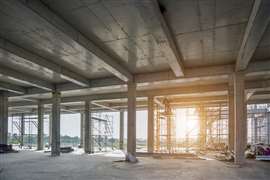Concrete’s carbon footprint: How can we scale up sustainable initiatives?
24 October 2023
Construction work won’t slow down so it’s essential to scale up sustainable initiatives and ways of working with concrete to put the environment first, reports Catrin Jones.
In the constantly changing world of construction, concrete serves as a cornerstone for modern infrastructure.
As the demand for robust, sustainable, and environmentally friendly solutions continues to rise, concrete companies are pushing the boundaries of innovation in both equipment and materials to meet these needs.
Concrete equipment has come a long way from manual mixing and pouring. Today, technological advancements have transformed the construction landscape, making it more efficient, accurate, and environmentally conscious than ever before.
Reducing CO2 emissions in concrete construction
LafargeHolcim has embarked on an ambitious journey to make its concrete production carbon-neutral by 2050. The company is investing in carbon capture and utilisation technologies, as well as exploring low-carbon binders that emit less CO2 during production.
Similarly, Cemex, another industry giant, has committed to producing 55% of its concrete with recycled or alternative materials by 2030, aiming to cut its carbon emissions significantly.
 A contractor takes delivery of customised equipment (Photo: Lintec and Linnhoff)
A contractor takes delivery of customised equipment (Photo: Lintec and Linnhoff)
The company recently announced its collaboration with Heathrow Airport in London, UK, and Ecocem on a trial aimed at exploring the potential of lower carbon concrete at the airport site.
The trial involves a comprehensive evaluation of the concrete’s durability and longevity in a real-life airport environment, following extensive lab and plant tests. Two lower carbon solutions will be put to the test initially: a mix with 50% GGBS (Ground Granulated Blastfurnace Slag) called Pavement Quality Concrete (PQC) and a zero-clinker product.
The eco-friendly concrete formulations will be poured at the airport’s designated site under the watch tower, as part of a phased process to assess their strength and resilience in practical conditions.
“We were the first supplier in the UK to launch a net-zero concrete product, making us ideally situated to support Heathrow with their lower carbon concrete trial,” said Richard Kershaw, technical manager at Cemex. “We hope this trial will demonstrate to the aviation sector the opportunities available to cut emissions during their development projects.”
Reducing and recycling
A key question for the sector is: how can it ensure that the equipment used to dispose and recycle concrete is done in a way that has minimal impact on the environment?
 Kleemann MOBIREX MR 130i EVO2 at work with the John Deere excavator 345GLE recycling concrete in California (Photo: Kleemann)
Kleemann MOBIREX MR 130i EVO2 at work with the John Deere excavator 345GLE recycling concrete in California (Photo: Kleemann)
Kleemann, part of Germany-based Wirtgen Group, has worked diligently to ensure that their impact concrete crushing machines are optimised to reduce the environmental impact of impact crushers during their operational life.
Tobias Böckle, head of product management, Kleemann, says that intelligent systems make the machine more efficient. “The innovative continuous feed system (CFS) ensures that the feed material is always conveyed with maximum efficiency through the machine. The filling level of the crushing chambers is monitored continuously, and the feed is adapted to the process,” says Böckle.
“This optimised process ensures that material wear is as low as possible. Furthermore, fuel consumption is also reduced – which is also beneficial for the environment.”
The applications for crushing plants are diverse and depending on the feed material and the desired end result, says Böckle, the parameters vary.
“The Smart Job Configurator supports operators in the selection and entry of the correct settings,” adds Böckle. “This ensures that the desired high-quality final product is reached with the lowest possible wear and fuel consumption.”
Sustainability is also a key focus for Ammann. The company recently opened a new factory in China which is said to be “a major turning point in the company’s growth plans for Asia”. The factory, located in Zhangjiagang, will manufacture asphalt-mixing plants and parts for China and beyond.
“The design of the new (manufacturing) plant adheres to the Swiss concept of environmental respect, i.e., reducing energy consumption, plant emissions, and its impact on the environment,” said Zhang Liguang, general manager of Ammann China at the opening event held in August.
The factory’s final products – the asphalt plants themselves – are said to be in adherence to tight Swiss sustainability standards. That includes Ammann’s global Green Plant initiative, which promotes sustainable technologies, innovative solutions, and environmentally friendly asphalt-mixing practices.
3D concrete printing
In recent years, the rise of 3D printing technology has made waves in the concrete industry. Companies like ICON are utilising large-scale 3D printers to construct entire buildings using concrete.
This method not only reduces the amount of material needed but also accelerates the construction process, significantly cutting down on project timelines. Such innovations are poised to revolutionise the construction industry by making it faster, more cost-effective, and eco-friendly.
 A 3D-printed hotel interior from US-based company ICON (Photo: ICON)
A 3D-printed hotel interior from US-based company ICON (Photo: ICON)
3D-printed buildings have typically been houses, but US-based ICON is taking it a step further by constructing a campground hotel in Texas, US.
“The truly unique and divergent architectures made possible by 3D printing are really just beginning,” said Jason Ballard, co-founder and CEO of ICON. “One of the great joys of ICON is putting our technology into the hands of great creatives and seeing what possibilities emerge.”
The new hotel and homes feature organic curves and domes that are said can only be achieved by 3D-printing. The hotel, named El Cosmico, will showcase entirely new architectural approaches made possible by large-scale 3D printing including domes, arches, vaults and parabolic forms.
Another project underway is the construction of one of Europe’s largest 3D-printed buildings. The project began in April 2023 with Peri 3D Construction and is expected to finish before the end of the year.
Commissioned by Kraus Group, the 53-metre long, 11m wide, and 9m tall structure will not have permanent residents but work as a server farm for local information technology provider Heidelberg iT.
The construction firm is using Cobod’s BOD2 printer. The machine will print walls for the building, which is almost 600m2 in area, 54m long, 11m wide and 9m high. Formwork and scaffolding specialist Peri’s 3D construction arm will provide the know-how for the construction, which involves using 200 cubic metres of pumpable concrete.
Concrete’s life cycle
From 3D-printed buildings to the concrete itself, it’s important that all stages in a building’s lifecycle are environmentally conscious.
Tee Peow Aik, COO of Lintec & Linnhoff Holdings, which manufactures concrete and asphalt batching plants, says that to ensure that the concrete production process adheres to the highest standards of

environmental protection and sustainability, they employ cutting-edge technologies to operate as efficiently as possible.
“Our future product generation will incorporate new and efficient machinery, coupled with comprehensive employee training measures,” says Aik.
The company highlighted that it uses advanced recycling technologies in its plants to repurpose existing road layers and incorporate them into new asphalt production. “This not only reduces the demand for fresh materials but also minimises the disposal of old asphalt,” he adds.
The company recently customised a standard Linnhoff CMX1500 asphalt mixing plant to meet specific requirements to win a first order from major Filipino contractor Vicente T. Lao Construction.
The advancements in equipment and materials brought forth by the industry are propelling the sector towards sustainability. These innovations not only enhance efficiency and accuracy but also prioritise environmental responsibility. The journey towards sustainable concrete production is undoubtedly challenging, but the future of concrete looks greener and more promising than ever before.
New VP of Engineering/R&D at GOMACO
 Scott Pedersen (Photo: GOMACO)
Scott Pedersen (Photo: GOMACO)
Concrete paving technology company GOMACO has announced that Scott Pedersen has been named as the company’s new vice president of Engineering/Research and Development (R&D).
Pedersen, who has been with the US-based company since 1995, replaces Kevin Klein who retired after 39 years of service to GOMACO, serving as a vice president for the company the past 16 years.
Under Klein’s leadership, GOMACO saw the advent of new models of curb and gutter machines, including the GT-3600 capable of pouring a two foot radius, and slipform pavers like the GHP-2800 with dual-telescoping abilities, along with several other models in the company’s full line of concrete paving equipment.
He also oversaw the evolution of the company’s machine control system and the advent of G+controls, GOMACO’s own industry-leading and proprietary control system. “Scott is the natural replacement for Kevin,” said Kent Godbersen, GOMACO’s vice president of worldwide sales and marketing. “He has worked closely with Kevin and managed the projects and personnel of the department and the R&D shop for the past 14 years.”
STAY CONNECTED



Receive the information you need when you need it through our world-leading magazines, newsletters and daily briefings.
CONNECT WITH THE TEAM








